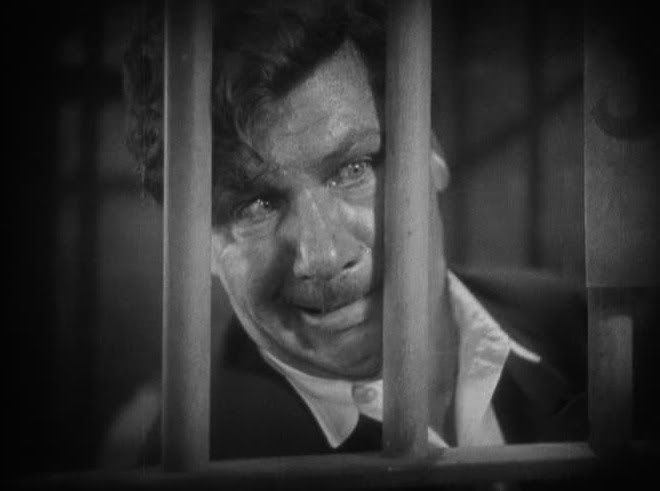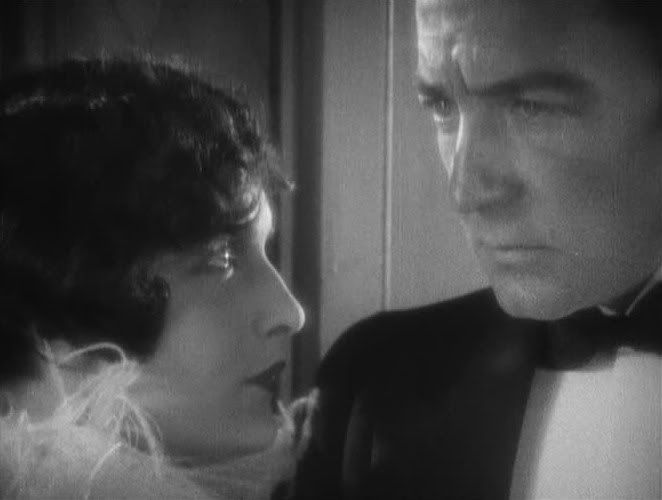
Josef von Sternberg's remarkable silent Underworld was a template for virtually the entire gangster film genre, an archetypal film that established much of the mythos and visual language of the genre. It is also, on its own merits and regardless of its subsequent influence and importance, a bracing and powerful film, a searing melodrama with a bluntly poetic visual style. The film's story is familiar now, focusing on a brutish gangster improbably named Bull Weed (George Bancroft), a man who believes he is above the law, that he can never be caught. He literally laughs in the face of law and propriety: a big, full-throated laugh, one that requires him to throw his head back and roar with forced hilarity when confronted with those who, unlike him, fear the law, or think he needs any help. Bancroft's performance is deliberately oversized, a big, bold performance for a big, bold man whose every gesture is theatrical and exaggerated. Bull is always performing, always putting on a show as a big man — he revels in handing out money, making a show of his generosity, and an equally big show of his toughness, as revealed by his habit of ostentatiously bending coins into U shapes, his face crunched up as he strains with the metal coin, demonstrating his strength and dominance. Bancroft's broad performance is perfectly suited to this gestural, hammy, outrageous figure.
This performance, and this character, was obviously a towering inspiration for the gangster genre in the years to come, as Bancroft's Bull Weed was echoed in later gangsters played by James Cagney and Paul Muni. Howard Hawks' Scarface, in which Muni broadly mugs as a similarly unflinching gangster, was especially influenced by von Sternberg's film. This influence on Hawks would reverberate into later works, and Hawks nodded to Underworld in Rio Bravo by naming his own heroine Feathers, after Evelyn Brent's character here, and paying homage to the sequence where a bully tries to get a drunk to go fishing for money in a spittoon. In von Sternberg's film, Feathers is Bull's girl, the bully is Bull's criminal rival Buck (Fred Kohler), and the drunk is ironically dubbed, by Bull, Rolls Royce (Clive Brook), a washed-up lawyer who still hasn't sunk so low that he'll go scrambling in filth for a few dollars. Rolls Royce isn't so proud, however, that he won't take Bull's money; when Bull befriends this drunk, perhaps seeing the nascent dignity and potential in him, he sets Rolls Royce up with some money and makes him his right-hand man.
Feathers is similarly indebted to Bull, even though she quickly falls in love with the cleaned-up, intelligent Rolls Royce. She asks Rolls Royce what he was before he was picked up by Bull, and after acknowledging that he was a bum and a drunk, he turns the question around on her. The look in her eyes says it all, without any intertitle to clarify: she was obviously a lowly character, perhaps a prostitute, and now she's a woman who, covered in feather boas and dressed in glamorous clothes, can turn the head of everyone in a room when she enters. Von Sternberg stages moments like this in glossy but expressive closeups, glistening with light that reflects off the shiny eyes of the protagonists as they grapple with loyalty, desire, and shame. Feathers and Rolls Royce are deeply conflicted, in love with one another but also feeling loyalty to Bull, and simultaneously ashamed of their reliance on this gangster. They know that their lives are built on illegal activity, and Rolls Royce even helps Bull with his crimes, instructing him on how to frame Buck for a stick-up job.

Von Sternberg's aesthetic, with his intense closeups and strikingly framed medium shots in shadow-strewn back alleys and bars, is perfectly suited to this tale of pent-up and violent emotions. Bull, in contrast to Feathers and Rolls Royce, doesn't hold anything back. He expresses everything, alternating bouts of rage with fits of laughter and cheerfulness that are just as fierce. When he sees Feathers and Rolls Royce dancing, he flies into a rage, outraged not that they were dancing, necessarily, but that his assistant hadn't asked for permission first: he speaks of Feathers as though she were his property, as though Rolls Royce should have simply asked to borrow her. A moment later, the incident is forgotten and Bull is back to cackling hysterically, as though nothing had even happened. He burns hard and fast, never holding back his jealousy or his anger or his enjoyment of some bit of nonsense. Everything he feels is immediately embodied in his expressive face. At one point, while he's standing trial and awaiting his sentence, he's distracted from the judge's words by the sight of Feathers and Rolls Royce sitting together in the courtroom. Von Sternberg focuses on a closeup of Bull's face, his eyes continually shifting to the side, away from the judge, looking towards his friend and his girl together; it is a portrait of all-consuming jealousy, jealousy built from a seemingly innocent image of these two people simply sitting next to each other. In Bull's mind, it becomes an intimate moment between lovers, and von Sternberg shoots the pair as though subtly confirming Bull's suspicions in the closeness of their bodies, in the small comforting pat on the hand Rolls Royce gives to Feathers, in the confining intimacy of the way they're framed together.
What's so remarkable about Underworld is that it's a seminal film, the impact of which has hardly been blunted by all the films to follow its example. Like many of its successors, it frames its story of an unrepentant gangster in the thin gauze of a social message — and even has Bull repent in the final act, an out-of-character gesture that does little to change his essential nature. But also like many later gangster pictures, Underworld is far more convincing at establishing the fun-loving persona and larger-than-life vitality of this vicious character than it is at tut-tutting his excesses. The film is fun, and frequently quite funny, with flashes of wit in the titles, like Feathers' insult/come-on to Rolls Royce, a bit of naughty innuendo disguised with an automobile metaphor. Later, there's even a gangsters' ball where "everyone with a police record will be there," a cartoonish conceit that calls attention to the film's wry, fantastical perspective on crime and gangsterism. This is a brilliant, strikingly shot example of the American gangster icon in his early stages of development, his edges at their roughest, his nastiness cut with playfulness and joie de vivre, his brutality softened by an almost unthinking generosity and tenderness. He's the kind of gangster who will machine-gun a cop one moment and feed a kitten some milk from his finger the next, and kittens sporadically caper through the film, symbols of innocence and play, oblivious to the gunfire and violence. The film, like its laughing, scowling antihero, is rough on the outside but hides the playful, spirited soul of a kitten underneath.
It's odd to think of Sternberg as the inventor of the gangster film. But that's what he and scriptwriter Ben Hecht did with this striking and wildly influential item. Hawks (who as we know went on to make one of the greatest of allgangster films Scarface) had Angei Dickinson's character in Rio Bravo named "Feathers" in tribute.
ReplyDeleteSternberg's first talkie, Thunderbolt, also a gangster film and also with George Bancroft, is equally fascinating.
Yeah, this was obviously a big influence on Hawks, as seen in Scarface and Rio Bravo especially (in the latter film, not only the naming of Feathers, but Hawks' famous opening with the coin in the spittoon).
ReplyDeleteSternberg's film is great in its own right, too, beyond its influence.
Underworld's a fine movie, and if future moviemakers credited it with influence, that's fine, but it seems closer to Tod Browning and Lon Chaney Sr's crime films than to the Warner films to come. They all seem like melodramas about criminals rather than crime films. Also, Bull Weed is a "crook" rather than a gangster; his primary activity seems to be theft rather than racketeering. What we call gangster films were about different kinds of criminals. Sternberg deserves a lot of artistic credit for this film, but it can get overrated historically.
ReplyDeleteFair enough, Samuel. I think it's in the performance style more than anything else that this film influenced the subsequent Warner gangster wave. Bull Weed might be a different kind of criminal from layer gangsters, but his bold, exaggerated style seems to me like an ancestor of Muni and Cagney in the gangster films to come.
ReplyDeleteBut then, I haven't seen the Browning films you refer to, so I don't know if those films are similar in that respect. Underworld just seems to be the film that a lot of later filmmakers referred to.
"Like many of its successors, it frames its story of an unrepentant gangster in the thin gauze of a social message..."
ReplyDeleteAbsolutely Ed, and UNDERWORLD exerted considerable influence on Prevert and Carne in addition to Hawks, (whom you mention in the review) UNDERWORLD is often thought of as the first film to use gangsters as heroes, and the sensuous Evelyn Brent later evolved in the Von Sternberg literature into Marlene Dietrich.
Of course this passage here is telling as well:
"Von Sternberg's aesthetic, with his intense closeups and strikingly framed medium shots in shadow-strewn back alleys and bars, is perfectly suited to this tale of pent-up and violent emotions..."
This delineates Sternberg's famed expressionistic style which of course is to be seen in a number of his early masterpieces.
Superb piece.
Thanks, Sam. Good point about the Brent character here being a precursor to Dietrich's roles with Sternberg.
ReplyDelete